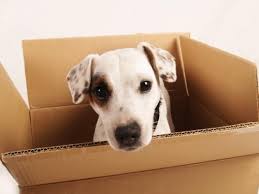MAKE MOVING EASIER FOR YOU AND YOUR DOG
By Nomi Berger
Dogs, like humans, are creatures of habit. Once comfortable in their surroundings, they are unnerved by change. And trading a familiar home for an unfamiliar one can cause fearfulness and stress. Unless you, the conscientious dog guardian, plan ahead with all the precision of a successful military campaign. Logically, then, moving from one place to another should consist of three stages: preparing for the move; moving day itself, and settling into your new home. You obviously have checked out your surroundings before moving to make sure it is compatible for you and your pet, however, many do not know the signs to look out for and can find themselves in trouble a few months into their new home. Websites such as https://www.homify.com/projects/885378/warning-signs-for-a-first-time-home-buyer can help by highlighting these signs so you and others do not fall victim to a bad home that may make you want to move again, or have you forking out a lot of money to keep you and your pet safe and comfortable.
PREPARING FOR THE MOVE
Once the move is finalized, and you’ve spoken with your real estate agent (be they one of the realtors Lynchburg has, or one based anywhere else), this is the time to begin preparing your pooch for what is to come. Purchase a large, comfortable carrier and give your dog sufficient time to adjust to being in it. Leave it on the floor with the door open and some treats inside. Keep replacing the treats after your dog has retrieved them.
Set out your cardboard, moving boxes a few days before you actually begin to pack so that your dog can get used to the sight and scent of them.
Maintain your dog’s regular routine for feeding, walking and playing, and quality together time.
If your dog becomes anxious as you start packing, place him/her in a quiet room with some toys and treats and keep the door closed. On the other hand, if yours is an especially nervous dog, boarding him/her in a professional kennel the day before and after the move may be the best solution — for all of you.
Make certain that your dog’s identification tags carry your new address and telephone number. But the best precaution — and the wisest investment you can make — is an updated microchip implant.
MOVING DAY ITSELF
Even before the Winnipeg moving company specialists take over the premises, tuck your dog safely away from the centre of the storm by closing him/her in a bathroom, together with food, water, some toys and his/her bed.
To ensure that your dog doesn’t panic and try to escape if the door is opened, put a sign on the door stating that it must remain shut.
Your dog should always travel with you, secure in the carrier, and not in the moving van.
SETTLING INTO YOUR NEW HOME
Put your dog in a room that will remain relatively quiet for awhile. Before opening the carrier, lay out your dog’s food, water bowl, toys and bed, and place some treats around the room.
Keep your dog in this one “safe” room for a few days, spending time together, soothing and cuddling, and sharing some low-key activities like reading, listening to music or watching TV.
Dog-proof your new home as soon as possible. Included in your “must do” list:
tuck drapery, blinds and electrical cords out of reach; ensure all windows and screens are secure; install child-proof latches on your cabinets – particularly those containing cleaning supplies; cover unused electrical outlets with special plastic caps, and keep all toilet seats down.
Begin gradually walking your dog through the rest of the place, one room at a time, constantly praising and reassuring him/her as you make the rounds. Over and over again.
Restore your dog’s former feeding, walking and playing routine so that, hopefully, it will seem that nothing has changed much at all.
Dogs may be creatures of habit, but they are highly adaptable as well. And so, whether familiar or unfamiliar, old or new, for them, there is still no place like home.


i have 3 dogs and moving always was easy to me. But in the begining it was difficult!